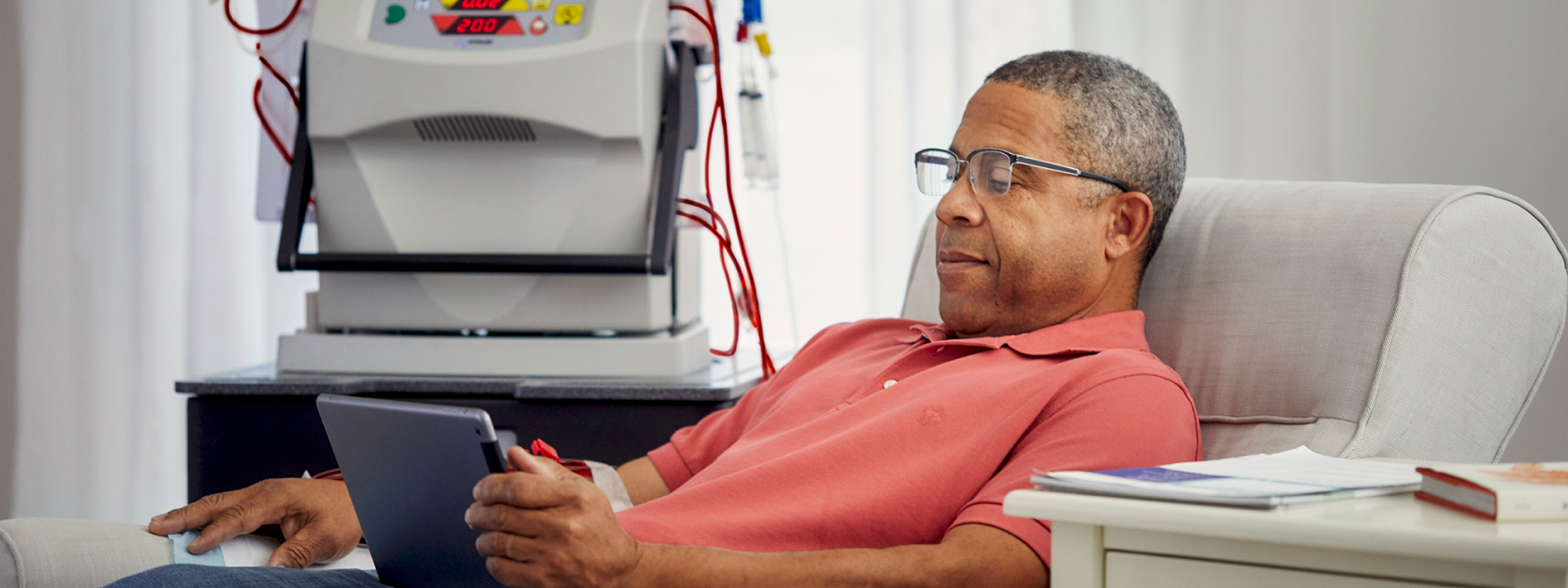Get Prepared for Home Dialysis
No matter which treatment type you choose, home dialysis offers many benefits—like the convenience of doing treatment on your own time and from the comfort of your own home. If you're worried about dialysis equipment taking over your home, don't be! With help from your care team, you'll be able to manage your treatment space with ease. Your care team is full of experts who can help you set up your space and organize your supplies so that you always feel right at home.
Whether you are doing home peritoneal dialysis (PD) or home hemodialysis (home HD), your care team will set you up for success and support you every step of the way.
Go to section:
- How to set up your home treatment space
- Tips for storing home dialysis supplies
- Get ready for home peritoneal dialysis (PD)
- Get ready for home hemodialysis (home HD)
- Feel confident with proper planning
How to set up your home treatment space
Our experienced home dialysis nurses and technicians can make treatment comfortable no matter what your environment looks like. They will visit you at home to help you decide where to set up your treatment area and how to store your supplies.
Your treatment space will need to be equipped with the following:
- A comfortable chair or bed
- Good lighting
- A clean room or area that can be closed off. Pets should not be in your treatment area while you are connecting or disconnecting your dialysis access site for treatment, as this puts you at risk of contracting bacteria or germs
- A telephone nearby so you can make a call during treatment if needed
- The right kind of electrical outlet, which will be set up for you by your tech team (part of your extended care team)
- A water source (if needed for treatment)
- Space for your dialysis supplies and equipment
- A bathroom drain or other plumbing to drain treatment fluids

5 tips for storing home dialysis supplies
- Consider stacking up, not out. Based on your space, you may have the option to stack some supplies vertically as long as they're stable. This could use less floor space.
- Maximize unused storage space. Try sliding supplies under beds or stacking them in closets, out of sight.
- Store small supplies in stackable storage drawers. Using drawers on wheels will let you move supplies out of the way when not in use.
- Order fewer supplies at a time. It’s best to have six weeks of supplies at home. If you have storage issues, you may be able to order a smaller amount of supplies more frequently.
- Unpack supplies from boxes. This can cut down on volume. Note that some supplies should remain in boxes if there’s a chance you’ll return them later.
Get ready for home peritoneal dialysis
Before you begin PD, your home dialysis nurse will visit with you in your home. Your nurse will check your home for safety and help you decide where to do treatments and store supplies. Be prepared to wait at least two weeks before starting home treatment. That's because PD requires up to two weeks of training, done in a center, for you to feel confident doing treatment at home.
Even though you can do PD on your own, a family member or care partner is always welcome to help you do exchanges. You will also have your care team, including your home dialysis nurse, to offer support.
Plan for your PD catheter
After surgical placement, your peritoneal dialysis catheter needs two weeks to heal—or possibly less, depending on the urgency to start treatment. If you know you're going to start PD eventually but you have some time before you start dialysis, you may be able to get a "buried" catheter placed in advance, so it's ready to go when you are.
Get ready for home hemodialysis
Before starting home hemodialysis (home HD), you will train for four to six weeks with a home dialysis nurse on how to use the equipment and get the most out of your treatment. If you have a care partner supporting your home dialysis treatments, they will be trained with you. Most people will do home HD with a care partner, but you may be able to do treatments independently as well. Talk to your care team to learn what treatment options are available for you.
Plan for your home HD access site
There are three hemodialysis access types: a fistula, a graft, and a HD catheter. Your nephrologist will help you determine which type is right for you based on the strength of your veins and your overall health. The healing process depends on which type of access you choose. A fistula takes six to eight weeks to heal and a graft takes two to three weeks. If medically necessary, you may have an HD catheter that can be used immediately after placement. However, the catheter has a higher risk of infection and should not be used as a permanent access site.
Experience the comfort and convenience of home dialysis with proper planning


